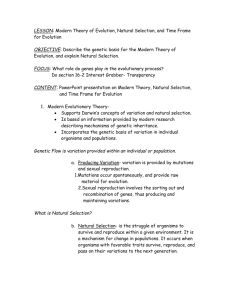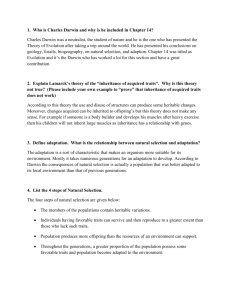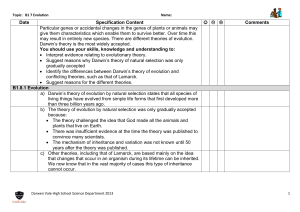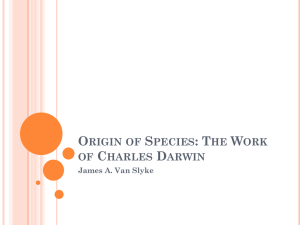Class 2 Notes
advertisement
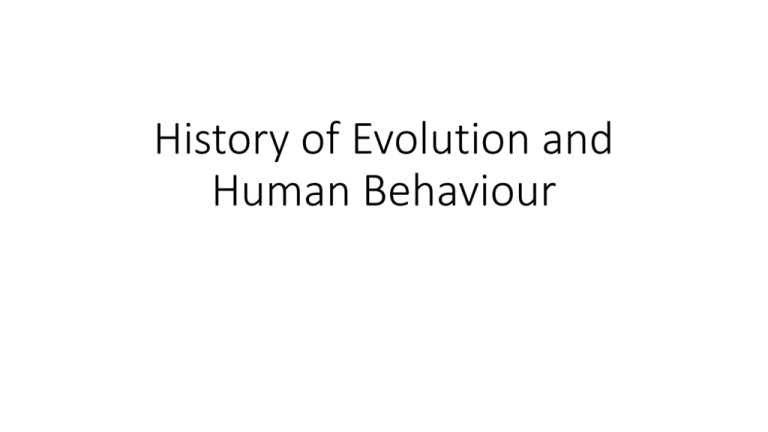
History of Evolution and Human Behaviour Evolution before Darwin Evolution • Change over time in organic (living) structure Jean Pierre Antoine • Causes of species change de Monet de • Natural tendency for organisms to advance to a higher form Lamark (1744• Inheritance of acquired characteristics 1829) Baron Georges • Catastrophism Léopold Chréitien • Species go extinct in catastrophes and Frédérick Dagobert are replaced by new species Cuvier (1769-1832) Lamarkian Evolution Natural tendency for organisms to advance to a higher form • Violates the Naturalistic fallacy • Words like “higher form” give a value judgment to each organism and it’s closeness in relatedness to humans • Different organisms have specialized for different environments • Degree of specialization does not indicate the degree to which something has evolved Inheritance of acquired characteristics happens via epigenetics, but not how Lamark thought… • Animals struggle to survive • The struggle makes the nerves secrete a fluid that enlarges the organs involved in the struggle • Strivings are passed down across generations Darwin’s Theory of Natural Selection Goals • Explain why living organisms change in form over time • Explain how new species emerge The Beagle Voyages (1831-1836) • Galápagos Islands • Each island had a different species of finch • Darwin thought they each had a common ancestor • Diverged because of differences in island habitat • Geographic variation in species was pivotal to Darwin’s theory Darwin’s Puzzle What accounts for why species change? Natural Selection • Variation • Inheritance • Selection Variation Organisms vary in phenotypic quality • Wing length • Trunk strength • Bone mass • Cell structure • Fighting ability • Defensive ability • Social cunning Variation provides the raw material for evolution Hawaiian honeycreepers Inheritance Only some variations are inherited • Lemark believed all acquired traits were inherited • Darwin believed variations such as wing deformity caused by environmental accident are not inherited • Only those inherited traits play a role in the evolutionary process We now know that genetics are the mode of inheritance • There are also epigenetic phenomena, but this plays a much smaller role • Darwin may or may not have read Mendal’s work on genetic inheritance, but this was not mentioned in Darwin’s writing Selection Organisms with some heritable variants Leave more offspring than those that have other heritable variants Because variants help with • Survival • Reproduction Survival Survival is not the goal of evolution Reproduction is the driving force Differential Reproductive Success • Survival only alters evolution when it affects reproductive success • Variation in prevalence of heritable traits that increase or decrease reproductive success across a population of conspecifics Darwin’s Theory of Sexual Selection • Certain traits did not fit Darwin’s theory of Natural Selection • Some traits had nothing to do with survival • Peacock feathers was one example • Peacock Feathers • Only males have elaborate trains • Energetically costly to produce • Attracts predators • Reduces ability to evade predators Darwin’s Theory of Sexual Selection Why are there structures that have nothing to do with survival? Why do the sexes often differ so much when they share the same problems of • Procuring food • Fending off predators • Combating diseases Darwin’s Theory of Sexual Selection Intrasexual competition Intersexual selection • Competition between members on one sex • Outcome contributes to mating access to the other sex • Winners of competition mate more often than losers • Traits that aid in successful competition increase in frequency across generations • Preferential mate choice for desired characteristics • Evolutionary change occurs because those possessing the characteristics are chosen as mates • Those traits are passed on to subsequent generations at higher frequencies Other Causes of Evolutionary Change Genetic Drift Artificial Selection • Random changes in genetic makeup of population • Mutation • Founder effects • Random Bottlenecks • Grafting • Animal Husbandry • Breeding/Crossbreeding • Cloning Founder Effect Loss of genetic variation that occurs when a new population is established by a very small number of individuals from a larger population. Bottleneck effect Population bottlenecks occur when a population’s size is reduced for at least one generation. • Genetic drift acts more quickly to reduce genetic variation in small populations • Bottleneck can reduce a population’s genetic variation by a lot, even if the bottleneck doesn’t last for very many generations. Artificial Selection Intentional breeding of organisms Evolution via natural selection Not intentional Not forward thinking Only acts on variants that exist Does not predict the future Does not foresee future needs Evolution is gradual The speed of evolutionary change is slow Punctuated Equilibrium Dozens Periods of no or very slow evolutionary change Millions Followed by periods of rapid evolutionary change of Generations Common questions Did humans descend from apes? How are partial adaptations useful? Where are the missing links? Why have humans stopped evolving? Isn’t it just a theory? Humans did not evolve from apes Humans did not evolve from apes How are partial adaptations useful? A partial wing can’t fly Partial wings • Why evolve a partial wing? • Provide warmth • Aid in mobility in catching prey • Jumping • Stabilization Argument from ignorance (Dawkins, 1986) • Difficulty in imagining an adaptive function for a trait is not evidence against such forms having evolved. Missing Links • There is no such thing as a missing link • The term “missing link” comes from the idea that we haven’t found transitional fossils between humans and apes Humans continue to evolve Wisdom teeth Cesarean Section • Humans are being born without wisdom teeth • Evolution supports a use-it or lose-it policy • Processed foods alleviate the requirement for wisdom teeth • Selection on skull size at birth is reduced • Head size at birth is allowed to grow Lactose tolerance • Developed 3000 years ago in East Africa Isn’t it just a theory? Fact Hypothesis Law Theory • In science, an observation that has been repeatedly confirmed and for all practical purposes is accepted as "true." Truth in science, however, is never final, and what is accepted as a fact today may be modified or even discarded tomorrow. • A tentative statement about the natural world leading to deductions that can be tested. If the deductions are verified, it becomes more probable that the hypothesis is correct. If the deductions are incorrect, the original hypothesis can be abandoned or modified. Hypotheses can be used to build more complex inferences and explanations. • A descriptive generalization about how some aspect of the natural world behaves under stated circumstances. • In science, a well-substantiated explanation of some aspect of the natural world that can incorporate facts, laws, inferences, and tested hypotheses.

